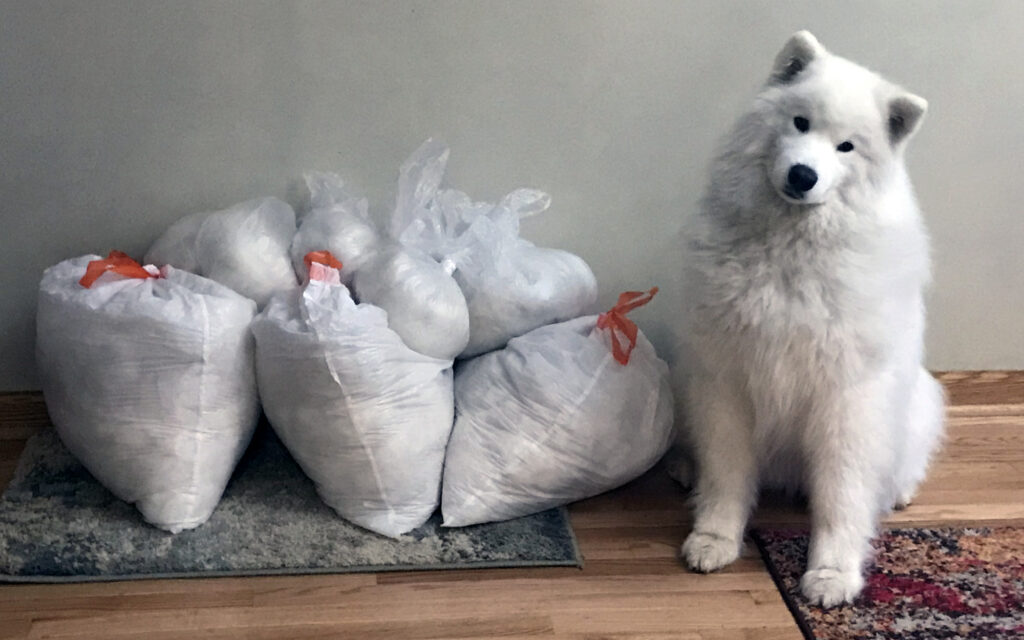The pelt of a Coast Salish woolly dog named Mutton, who died in 1859, is currently housed in the Smithsonian collections.Brittany M. Hance/Smithsonian
Posted on 12/26/2023 7:32:19 PM PST by SunkenCiv
Ancient DNA from the pelt of a fluffy white dog named Mutton is revealing new details about the woolly dog, an extinct breed that was cared for and raised by the women of the Coast Salish tribal nations in the Pacific Northwest. The small dogs... were fed a special diet of fish or elk, and they were shorn like sheep, their wool woven into special blankets and textiles.
For thousands of years, woolly dogs were cherished as family members and raised on islands or kept in pens to ensure they didn't interbreed with other dogs, according to Michael Pavel, an elder of the Skokomish-Twana tribe and one of the authors of the study, published Thursday in the journal Science. The last woolly dogs disappeared around the end of the 19th century, but they have been kept alive in stories passed down by Coast Salish elders...
Woolly dogs split from other dogs in North America somewhere between 1,900 and 4,800 years ago, the data show. Mutton had only 16 percent ancestry from European dogs — a tiny contribution that, to researchers who study ancient dog DNA, signifies the care with which they were raised even decades after European settlers arrived...
In the mid-19th century, George Gibbs, a naturalist and ethnographer working for the Northwest Boundary Survey for the U.S. government, adopted a woolly dog named Mutton.
Little is known about Mutton's life, but in August 1859, a naturalist working with Gibbs in southwest British Columbia wrote to a curator at the Smithsonian Institution that Gibbs's dog, who had recently been sheared, had eaten the head off a goat skin they had collected.
(Excerpt) Read more at washingtonpost.com ...
The pelt of a Coast Salish woolly dog named Mutton, who died in 1859, is currently housed in the Smithsonian collections.Brittany M. Hance/Smithsonian
I remember that song — about the Dog Weaver
Pacific Northwest, 1859 in a native village…fish and elk doesn’t seem that “special” of a diet in this circumstance.
Yeah, and Gary Wright also charted with “Dog is Alive” and “Dog is a Rose”.
My dog is quite good a knitting. Rubbish at weaving.
These dogs were owned by the women and usually kept on an island apart from other dogs to preserve their unique traits. The wooly dogs were sheared like sheep annually, and the fur spun into two types of yarn for use in weaving excellent textiles.
What, no Alpo? Seriously, what else did the Salish have?
My dog weaves sometimes, sashay’s other times.
Salish weavingSalish weavers used both plant and animal fibers. Coast Salish peoples kept flocks of woolly dogs, bred for their wool, to shear and spin the fibers into yarn. The Coast Salish would also use mountain goat wool, waterfowl down, and various plant fibers including cedar bark, nettle fiber, milkweed and hemp. They would combine these materials in their weaving. A type of white clay was pounded into the fibers, possibly for the purpose of extracting oil from the wool. Not all Salish blankets were made with dog's wool—commoners' blankets were usually made of plant fibers. The designs of Salish weavings commonly featured graphical patterns such as zig-zag, diamond shapes, squares, rectangles, V-shapes and chevrons.
In the early to mid-nineteenth century, the fur trade brought Hudson's Bay blankets to the Pacific Northwest. The influx of these cheaper, machine-made blankets led to the decline of native wool blankets that were expensive and labor-intensive to produce. Salish weaving continued to a lesser extent, but the weavers largely transitioned to using sheep's wool yarn brought to the area by traders, as it was less costly than keeping the salmon-eating woolly dogs.
There was a revival of Salish weaving in the 1960s, and the Salish Weavers Guild was formed in 1971.

Mine weaves quite a bit after a bowl of whiskey.

I-5 in downtown Seattle?
The dogs are much more expensive to keep than sheep, and are not as efficient at producing wool.
When they got the chance to use more efficient materials, they did.
In other news, they preferred using firearms to hunt with, and they preferred steel harpoon heads to bone or wood harpoon heads.
It is claimed they preferred matches to carrying a live coal.../S
Never knew about a wooly dog before. Interesting!!

https://attheu.utah.edu/facultystaff/origin-and-disappearance-of-coast-salish-woolly-dog/
I have a sister who used to brush her miniature collie and spin the fur into yarn to make very warm things. She used Kool-Aid to dye it different colors, as the undercoat was usually pale gold to white.
I don’t know if she does any spinning these days, as her health isn’t all that good, but I loved the yarns she spun and sent me! They were always lucious.



Disclaimer: Opinions posted on Free Republic are those of the individual posters and do not necessarily represent the opinion of Free Republic or its management. All materials posted herein are protected by copyright law and the exemption for fair use of copyrighted works.